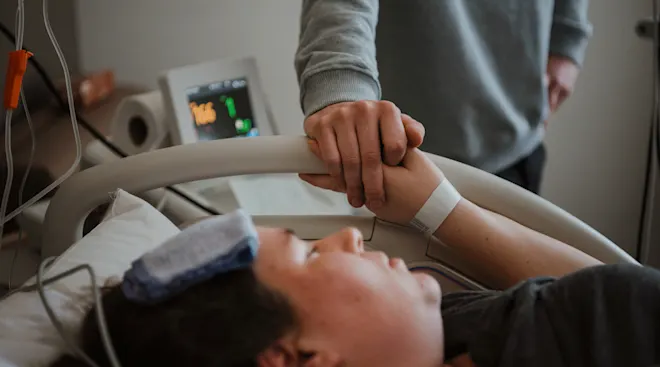What Happens Right After Baby Is Born?
You know all about contractions. You’ve wrapped your head around dilation. You have your deep breathing down pat. You’re as ready as you’ll ever be to push. But what happens immediately after you deliver baby? There’s the much-anticipated first snuggle, baby’s official weigh-in and lots of checks to make sure both of you are doing just fine. “The post-birth period is a really important time for bonding with your baby, while the nursing team is also monitoring your baby closely to make sure they’re adjusting as expected to life outside the womb,” says Monica Svets, MD, an ob-gyn at Cleveland Clinic in Ohio. Here’s a rundown of what happens immediately after baby is born.
Your baby’s lungs will typically fill with air a few moments after delivery, allowing for the all-important first breath! But don’t freak out if you don’t hear a cry right away. “Some babies may cry right away, some may not,” explains Svets. “We like when babies cry, as it helps to clear fluid from their respiratory tract, so nurses will encourage the baby to cry/breathe by vigorously drying the baby and rubbing the baby’s body.”
One exception: If there is meconium (a green, sticky substance that’s baby fecal matter in-utero) in the amniotic fluid, often the doctor will want to suction baby’s mouth before the first breath so it isn’t inhaled into the lungs, says Jaqueline Worth, MD, co-author of The New Rules of Pregnancy and co-founder and co-physician at Village Obstetrics and Village Maternity. If your baby does inhale meconium, they may need to be on antibiotics and monitored in the NICU for a few days.
Your OB will clamp the cord within seconds or minutes after birth. Both the American College of Obstetricians and Gynecologists (ACOG) and the American Academy of Pediatrics (AAP) recommend delayed cord-clamping, meaning doctors wait anywhere from 30 to 60 seconds or until the cord stops pulsating, which usually happens within five minutes, says Worth. That’s because in full-term infants it boosts hemoglobin levels and iron stores, and increases circulation and red blood cells in preterm infants.
Once the clamp is in place, the cord is cut by either your doctor or birthing partner, leaving behind a stump that will dry up and fall off on its own after a couple weeks. If you’re choosing to bank your child’s cord blood, the doctor will collect that at this point as well, Worth says.
If you delivered vaginally, baby is healthy and you want immediate skin-to-skin contact (also known as kangaroo care), your OB will lay baby on your bare chest or tummy right after delivery and drape a blanket over the two of you to keep baby warm. If your little one’s vitals remain steady, they can stay there for most of the post-delivery routine that follows. Skin-to-skin contact has been shown to regulate baby’s heart rate, breathing and body temperature, stimulate baby’s interest in feeding and help to calm both of you and boost the mother-child bond.
If you have a c-section, that skin-to-skin connection may be delayed, but only briefly. Once the baby is delivered, they’ll get a quick physical assessment and bundled up before being handed back to your partner or birth support person while the surgery is completed. You can then cuddle with baby at the head of the bed until it’s time to enter the recovery room for full skin-to-skin contact. “This delay is usually insignificant, typically less than one hour,” Svets says.
Along with skin-to-skin comes your first chance at breastfeeding, if your plan is to nurse. Bringing baby to your breast as soon as you can will start sending messages to your brain to begin milk production and letdown, Svets explains. Baby will initially receive colostrum, a thick fluid that’s rich in immunoglobulins and amino acids, which helps baby build their immune system—it’s the only food your newborn will need for the next few days until your milk fully comes in, usually two to five days after birth. Be sure to ask for help if you’re having trouble getting baby to latch: Your hospital will have lactation consultants on staff for just this reason!
Most placentas deliver spontaneously within the first few minutes after birth, Worth says. You may not even notice it happening! But if it takes longer than 30 minutes, or if you’re bleeding heavily, your doctor will remove it manually.
One minute and then five minutes after your child is born, your OB will assess baby’s post-delivery condition using the Apgar test. Your doctor will look at baby’s heart rate, breathing, muscle tone, reflexes and skin color, and will give each category a value of 0, 1 or 2, and then all scores are totaled. “The five-minute score is the most important because it takes a baby a few minutes to get acclimated and start breathing,” explains Judith Lothian, PhD, RN, a maternal-child nurse and childbirth educator and associate professor at Seton Hall University College of Nursing.
The highest total score possible is a 10, although babies rarely score a 10, Lothian says—7 to 9 is considered a high score and is given to newborns who appear healthy and don’t require additional assistance, while a score below 7 can indicate that baby needs pediatric or NICU attention. But try not to read too much into the scores. “A lower score does not necessarily mean that a newborn is unhealthy or that something is seriously wrong,” Svets cautions. “Perfectly healthy babies can sometimes have a lower-than-usual score, especially in the first few minutes after birth.” It might also just indicate that baby needs suctioning or oxygen to help them breathe better or closer monitoring in the nursery or NICU. The Apgar test is a simple assessment of baby’s wellbeing in the moment and definitely doesn’t predict baby’s future health.
Soon after birth, the nurses or pediatrics team will also do a detailed physical exam of baby in the delivery suite, Svets adds. They’ll measure your child’s temperature, heart rate, weight, length and head circumference. Plus, they’ll double-check that there aren’t any birth injuries or obvious issues. If there’s anything they need to check further, they may decide to bring baby to the NICU. Otherwise, if all looks good, then back to Mom the baby goes!
Within an hour of arrival, baby will be given a Vitamin K injection to help with blood coagulation. “Newborns can be deficient in Vitamin K, which puts them at risk for internal bleeding,” Worth explains. A nurse will also put antibiotic drops in baby’s eyes to help prevent infections. Most states require vitamin K shots and eye drops by law. The hepatitis B vaccine usually comes a little later, within 12 hours of delivery or at an in-office appointment with your child’s pediatrician.
Please note: The Bump and the materials and information it contains are not intended to, and do not constitute, medical or other health advice or diagnosis and should not be used as such. You should always consult with a qualified physician or health professional about your specific circumstances.
Plus, more from The Bump:
Monica Svets, MD, is an ob-gyn at Cleveland Clinic in Ohio. She earned her medical degree from Wright State University School of Medicine in Dayton, Ohio, and is a member of the American College of Obstetrics and Gynecology, the American Medical Women’s Association and the American Medical Association.
Jaqueline Worth, MD, is a New York City-based ob-gyn, co-author of The New Rules of Pregnancy and co-founder and co-physician at Village Obstetrics and Village Maternity. She graduated from Columbia University’s College of Physicians and Surgeons and has nearly 20 years of experience delivering thousands of babies.
Judith Lothian, PhD, RN, LCCE, FAAN, is a maternal-child nurse and childbirth educator and associate professor at Seton Hall University College of Nursing with more than 40 years of experience. She is also a member of Lamaze International's board of directors and a nationally recognized speaker on birth and breastfeeding.
Learn how we ensure the accuracy of our content through our editorial and medical review process.
Navigate forward to interact with the calendar and select a date. Press the question mark key to get the keyboard shortcuts for changing dates.




















































